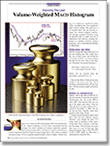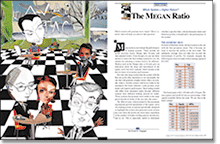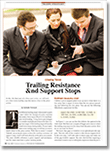Letters To The Editor
December 2009 Letters To The Editor
The editors of S&C invite readers to submit their opinions and information on subjects relating to technical analysis and this magazine. This column is our means of communication with our readers. Is there something you would like to know more (or less) about? Tell us about it. Without a source of new ideas and subjects coming from our readers, this magazine would not exist.
Address your correspondence to: Editor, Stocks & Commodities, 4757 California Ave. SW, Seattle, WA 98116-4499, or E-mail to editor@traders.com. All letters become the property of Technical Analysis, Inc. Letter-writers must include their full name and address for verification. Letters may be edited for length or clarity. The opinions expressed in this column do not necessarily represent those of the magazine. —Editor
VOLUME-WEIGHTED MACD
 Editor,
Editor,
The article “Volume-Weighted Macd Histogram” by David Hawkins in the October 2009 issue is certainly well written and instructive. However, it fails to note that the Vwmacd was originally developed by Buff Dormeier, Cmt. His 2007 paper, “Price & Volume, Digging Deeper,” on volume-weighted moving averages, is available at:
https://www.mta.org/eweb/docs/2007DowAward.pdf
The earliest reference to the Vwmacd actually appears to be in Bollinger On Bollinger Bands, John Bollinger’s excellent 2002 book. Bollinger attributes the idea to Dormeier in Chapter 18 and presents the formulas for the indicator. I believe at that time, Dormeier’s work was unpublished.
The field of technical analysis has a deep history. Dormeier’s work is a valuable addition to that, and David Hawkins demonstrates how to extend the original idea. They both deserve recognition in your magazine.
—Mike Carr
Thank you for pointing this out. In the July 2007 issue of S&C, we presented an article written by Buff Dormeier titled, “Between Price And Volume,” available from our online store at www.traders.com.
Mike Carr is a regular contributor to our online publications, Traders.com Advantage and Working Money, both found at our website, www.traders.com
—Editor
ERRATA: VOLUME-WEIGHTED MACD
Two errors occurred in the October 2009 article, “Volume-Weighted Macd Histogram” by David Hawkins. In Figure 5, on the right-hand side, the purple label should have read “22-day Vwma,” not “22-day Ema.” In addition, on page 30, in the second paragraph, the date should have read April 28, 2009, not February 28, 2009. We regret these errors.
VOLUME-WEIGHTED MACD AND TRADERS’ TIPS
Editor,
I just started to read your magazine. I found it in Borders bookstore and really enjoy it. I particularly found the article on constructing a volume-weighted Macd (“Volume-Weighted Macd Histogram,” October 2009 S&C) of interest. I personally use ThinkorSwim. I was wondering how I could get the code for this software. I found what seems to be nearly every other software’s code detailed toward the back of the magazine. I have no experience building indicators so it would be of great help to get code.
—Loren Judson
While a large number of technical analysis software developers contribute formulas or code regularly to our monthly Traders’ Tips column, for those not found there, we suggest you contact the software developer directly.
—Editor
MEGAN RATIO SYSTEM RETURNS
Editor,
I found “The Megan Ratio” by Oscar Cagigas in the January 2009 issue of Stocks & Commodities to be an excellent article.
I am interested in the system 1 used in the article. I backtested the system, but I did not get the same results. Can the author provide some additional explanations for the following:
- There were 30 stocks in the portfolio. How do the “77 trades” fit in?
- Buys and sells are different for each stock. Did he put an equal percentage of funds in each stock?
- Is the return compounded each time?
Thanks again to the author for providing such a useful trading idea.
—Rasik Shah

Oscar Cagigas replies:
Thanks for your comments regarding my January 2009 article. System 1 is simulated using AmiBroker with the following settings:
From 1/1/2000 to 1/1/2008 Portfolio simulation of 30 stocks listed in the article Initial equity = 100,000 No margin, no commissions Long only Use previous bar equity for position sizing All equity available is assigned to the BUY signal Round lot size = 1 Max open positions = 4 Limit trade size as 10% of entry bar volume
Trading size is reduced in low-priced stocks (<$5). Fortunately, the AmiBroker software provides very realistic results. It is also possible to select which stocks AmiBroker should choose for the buy signal if several are available simultaneously using the Positionscore variable, but I haven’t used it in the simulation and I am not sure about the algorithm of selection when Positionscore is not established.
For your convenience, I have uploaded the trades to my server. Please find them in:
https://www.onda4.com/files/system1.xls
https://www.onda4.com/files/system2.xls
https://www.onda4.com/files/system2filtered.xls
TIME FRAMES FOR TR&NDS METHOD
 Editor,
Editor,
I was reading Sylvain Vervoort’s article in the July 2009 S&C (“Trailing Resistance &nd Support Stops”) and was most interested in the Tr&nds system out of the three trailing stops that he has written about. I was wondering what time frames he would consider this method would work with. I generally like to use between five to 60 minutes. Would he consider this too short for the system, and would any of the settings such the Atr [average true range] multiplication need to be modified? I only trade equities currently.
—Glenn
Sylvain Vervoort replies:
If using Tr&nds for stocks on a time frame smaller than daily, you should make some small changes to the formula.
The lowest time frame I use on stocks is 15 minutes and one hour. For these time frames, I change the default for the Atr multiplication factor to 2.1. Also, in the formula, I change the percentage change tracking.
Here is the original part of the formula and following that, the modified one:
support:=If(L>=Ref(L,-2) AND Ref(L,-1)>=Ref(L,-2) AND Ref(L,-3)>=Ref(L,-2) AND Ref(L,-4)>= Ref(L,-2),Ref(L,-2), If(L>Ref(H,-1)*1.0013,Ref(H,-1)*0.9945, If(L>PREV*1.1,PREV*1.05, PREV))); support:=If(L>=Ref(L,-2) AND Ref(L,-1)>=Ref(L,-2) AND Ref(L,-3)>=Ref(L,-2) AND Ref(L,-4)>= Ref(L,-2),Ref(L,-2), If(L>Ref(H,-1)*1.0013,Ref(H,-1)*0.9945,If(L>PREV*1.01,PREV*1.0075,
PREV)));
TRAILING STOPS AND HEIKIN-ASHI CANDLESTICK OSCILLATOR
 Editor,
Editor,
I am writing to say how much I appreciate all of Sylvain Vervoort’s articles in S&C and to ask him a question.
My subscription to Stocks & Commodities had lapsed but I kept looking at the magazine on the newsstand to see if any good articles would appear. In late May 2009, I saw the article “Trailing Stops.” The article was very good so I also bought the next issues: June and July 2009. I am renewing my subscription because I don’t want to miss any of Vervoort’s further contributions.
I have used MetaStock for years without coming up with a reliable system, but his articles have gotten me closer. The system tester has been an issue for me and the documentation has not helped.
My first question for Vervoort is how to set up the system tester so that I get accurate results. This has been my biggest problem. I would like results that can be checked by using Explorer and manually calculating gains and losses. It now appears that if I set up the trades to occur at the next day’s open/close and use a delay of one day, I get more realistic numbers since I am an end-of-day trader. What would be his recommendation?
My second question: I am very intrigued by your heikin-ashi candlestick oscillator (“Trading With The Heikin-Ashi Candlestick Oscillator,” December 2008, S&C) and feel it has promise in finding buy/sell points. But the code is too big to fit into the system tester (version 10.1) and I am using it in Explorer. Is there any way to rearrange the code to use in the system tester? I have created several indicators: Haco34, Haco40, Haco45, and so on, with both buy and sell versions, allowing me to use the system tester using one Fml (“Haco”?) at a time and compare results, but it would be better if I could use the option’s capability of the system tester. Any thoughts?
I look forward to his soon-to-be-published book.
—Jay
Sylvain Vervoort replies:
Thanks for your letter.
If you cannot trade the same day near the closing price, the best next thing you can do is trade at the opening price the next day. On average, with most formulas, this will give comparable results over a longer time period.
The size limitation of the system tester is one of those things, among others, I would like to see adapted by Equis International, developer of MetaStock. Unfortunately, there seems to be more emphasis now on fundamental analysis.
The only thing you can do is take out some parts of the formula and create an external formula. You can adapt the default value in the external formula to test with different settings. In general, I would not advise purely trading on one indicator. This will not usually be profitable. You will need to combine it with other technical analysis techniques to make it into a profitable system, meaning you have to avoid some trades on buy signals and stay in some trades on sell signals. Only then will it be really profitable.